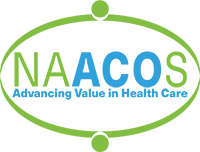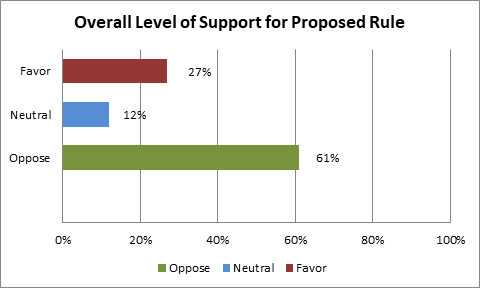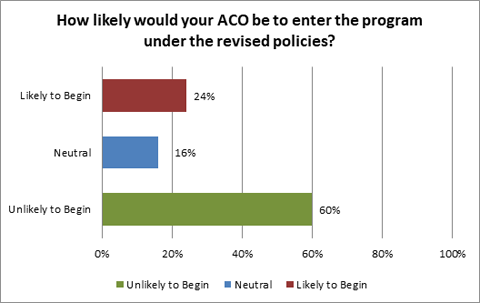|
Click to see NAACOS Comments on Proposed Pathways to Success Rule Key Findings from ACO Poll on CMS’s Proposed Pathways to Success RuleOverview: This report shares results from a poll conducted by the National Association of ACOs (NAACOS) to collect feedback in response to a recent regulation proposed by the Centers for Medicare & Medicaid Services (CMS). On August 9, 2018, CMS released a proposed rule that would set a new direction for the Medicare Shared Savings Program (MSSP) referred to as the “Pathways to Success” rule. The proposal, summarized by NAACOS here, would improve the existing MSSP in a number of ways but also presents some challenges for ACOs. To inform our understanding of ACOs’ opinions on the proposals and shape our comments to be representative of ACO views, NAACOS conducted a poll of all MSSP ACOs soliciting feedback about the rule, and the results are presented below. This poll is a follow up to one conducted this spring prior to the release of the proposed Pathways to Success rule, in which NAACOS solicited feedback from 82 ACOs that began the MSSP in 2012 or 2013 and remain in Track 1 in 2018. The CMS rules in place at the time of that poll required these to move to a risk-based model in 2019. Of the ACOs that responded to that poll, 71 percent indicated they were likely to leave the MSSP as a result of having to assume risk. The findings in this recent poll build upon those earlier findings and provide more updated ACO feedback specific to the proposed Pathways to Success rule. Specifics about the Proposed Pathways to Success ACO Poll: NAACOS developed a web-based questionnaire using Survey Monkey and solicited responses from all current MSSP ACOs in late September/ early October. A link to the poll was emailed to ACOs along with a few reminders to complete the questionnaire. There were 153 respondents, representing 127 unique ACOs and a response rate of 23 percent of MSSP ACOs. Key Findings Chart 1: Overall Level of Support for Proposed Pathways to Success Rule
The high proportion of ACOs opposed to the rule is concerning and reflects some of the key challenges in the proposal that overall outweigh a number of proposed positive elements. As shown in Chart 2, ACOs had clear concerns about specific proposals in the rule. Chart 2: Most Significant Challenges for ACOs in the Proposed Pathways to Success Rule
ACO respondents identified the biggest challenge in the rule as the proposal to dramatically cut shared savings rates from the current 50 percent to as low as 25 percent. Comments from respondents reflect deep concerns about ACOs’ ability to continue operations with such low shared savings rates. ACOs rely on shared savings payments to fund critical activities and infrastructure including hiring care coordinators, enhancing health information technology, investing in population health management and analytics and running ACO operations. Finalizing this proposed reduction in shared savings rates would not allow ACOs to recoup these investments and would deter participation in the MSSP. As one respondent noted, “The shared savings is what the ACOs use to help offset the additional costs, so cutting the savings in half doesn't make any sense.” The second most common concern (selected by slightly more than 50 percent of respondents) was the proposal to designate ACOs as “high” or “low” revenue, a policy that if finalized would require high revenue ACOs to assume greater amounts of risk more quickly. Using the proposed CMS calculation of high and low revenue ACOs, hospital or health system based ACOs would typically fall into the high revenue category. There were a number of comments from rural ACOs about being affected by this proposal, with one respondent commenting that there is, “no consideration of the challenges rural providers face as they move to value-based care/ACOs particularly related to limited resources, financial reserves and skills with actuary data analysis.” Added another, “If the high revenue distinction and impact is not removed, our ACO will drop out of MSSP entirely. I suspect this is true of many ACOs with small community hospitals as part of their group.” Many ACO respondents reported concerns about the significant amounts of risk in the Enhanced Track, which is equivalent to the current voluntary MSSP Track 3. Participation in the Enhanced Track would be required for high revenue ACOs, with some required to move to this track as early as 2021. “We are currently in year one of Track 1+. The proposal would force us into the Enhanced Track with substantially more risk than we are likely prepared to take on at this time,” one respondent wrote. The third most notable concern identified by ACO respondents is CMS’s proposal to shorten the time ACOs have in a shared savings-only model from the current six years to two years. Under the proposal, ACOs would progress from shared savings-only to risk-based models under timeframes that apply to ACOs differently depending largely on previous program experience and ACO type (high vs. low revenue). Under the proposal, new ACOs would have only one year of performance data available at the time they would be evaluating the required move to a risk-based model for performance year 3. NAACOS supports ACOs moving to risk but emphasizes the importance of an appropriate path to risk, including reasonable speed with which risk is required and attractive shifts in savings. These key elements are critical when determining how ACOs assume risk. Many respondents expressed concerns with the ability of ACOs, especially those new to the program, to assume risk as quickly as in performance year three as proposed. “There is no cookie cutter approach to ACOs and each market is different,” one ACO respondent wrote. ““I think that ACOs need more time to achieve savings.” The fourth challenge from the proposed rule selected by respondents is the proposal to modify the MSSP risk adjustment methodology to apply a symmetric +/-3 percent risk ratio cap between the performance year renormalized risk score and the most recent benchmark year for all assigned beneficiaries. While this proposal was selected as a top challenge, it was also selected as a top opportunity in the rule. Specifically, 31 percent of respondents selected this as a top challenge and 24 percent selected this as a top opportunity. This split likely reflects the effect of the proposed changes on specific ACOs, which differs depending on their particular circumstances. Further, this divide likely illustrates the effect of applying the proposed risk adjustment cap across a five-year agreement period. Many respondents supported the proposal to modify the risk adjustment methodology by allowing risk score changes over time but noted that the 3 percent cap will create challenges in the later years of the agreement after which point many ACOs would have surpassed the 3 percent cap. Chart 3: Most Significant Opportunities for ACOs in the Proposed Pathways to Success Rule
ACOs expressed support for a number of proposals in the rule and the top three opportunities were clear and are shown in Chart 3. Just over 55 percent of respondents selected their ability to choose an assignment methodology annually, regardless of MSSP track or level, as the biggest opportunity in the proposed rule. The proposed program flexibility would provide ACOs with more choices and let them move to a risk-based model without requiring them to move from retrospective to prospective assignment, as is currently the case with moving to MSSP Track 3 or Track 1+. ACO respondents also noted their support for proposed changes that would expand patient access to care by allowing ACOs to offer telehealth services in patient homes and expand the use of a popular waiver that allows beneficiaries to access skilled nursing facilities without having a hospital stay first. ACOs would also be allowed to offer beneficiary incentives, letting certain ACOs pay seniors up to $20 for qualifying visits. Overall, 42 percent of respondents selected the expanded use of these waivers and introduction of the beneficiary incentive program as a leading opportunity proposed in the rule. Citing a desire for increased program stability and predictability, slightly more than 30 percent of respondents chose the proposed shift from three-year to five-year agreements as the third most popular opportunity included in the rule. Following the selection of the top three opportunities, there were a few other opportunities selected by respondents which had similar results, including the risk adjustment proposals shown in Chart 2 and discussed above as well as the proposal to more gradually ramp up risk over the course of a five-year agreement period. A roughly equal proportion of respondents selected the proposed changes to the benchmarking methodology as an opportunity and as a challenge, 25 percent and 24 percent, respectively. This could reflect the combination of a few proposals to the benchmarking methodology and the specific effect on a particular ACO. Chart 4: Likelihood of a Current MSSP ACO to Continue under the Revised Pathways to Success Rules
After weighing the collective proposals in the rule, almost half of ACOs report they are likely to continue participating in MSSP. While more ACO respondents report being likely to continue, more than a third report they are unlikely to continue.[2] The significant proportion of ACOs that report considering leaving the program is deeply concerning, especially given the numerous recent examples of positive ACO performance and data evaluating their contributions to reduce spending and improve quality. “It takes almost two years to get actionable cost/quality data from CMS regarding ACO performance. It takes years to change provider behaviors based on this data and CMS now expects ACOs to take risk in a vacuum of data and with everchanging rules?” one ACO respondent wrote. “CMS continues to ignore the financial risk that providers incur to start ACOs. Legal fees for infrastructure, high cost of health IT that doesn't work as promised, cost of additional care coordinators, analytic talent, etc. We have no time to recoup our costs and learn what is needed to create savings. This has cost our small group of providers $1.5 million in expenses.” Chart 5: Likelihood of a New ACO Entering the Program under the Proposed Pathways to Success Rule
Equally or perhaps more concerning is the high number of ACOs, 60 percent, that report they would be unlikely to begin the MSSP if their ACO was not already participating and if they were evaluating the program under the revised policies.[3] This result reflects that while there are some positive proposals in the rule as highlighted by those selected as key opportunities by respondents, on balance the challenges in the proposed rule outweigh those opportunities, especially as they would pertain to new ACOs considering entering the program. As one respondent noted, “The majority of proposed changes in the NPRM are logical when isolated by themselves, but what appears to have been lost is that this rule now creates a significant barrier to entry and/or continuation for many organizations, impacting both how the program’s growth and how provider organizations balance the value-based transition,” one respondent wrote. “If MSSP is to remain a growth engine for accountable care, the rule will need to be softened to allow organizations time to adjust infrastructure.” Discussion The ACO community wants to help CMS work through issues in the rule which, if finalized as proposed, would have unintended consequences of undermining the broader shift to value-based care. Specifically, concerns cited by survey respondents focus on proposals to shorten the time new ACOs have in a shared savings-only model from six to two years, to designate certain ACOs as high revenue and require them to assume more risk more quickly, and to cut in half the shared savings rates for many ACOs from 50 percent to 25 percent. We request that CMS modify these proposals for all ACOs in the final rule. Specifically, we request CMS to allow at least four years for ACOs in a shared savings-only model, to not create a distinction between high and low revenue ACOs, and to apply a shared savings rate of at least the current 50 percent. The MSSP remains a voluntary program, and it’s essential to have the right balance of risk and reward to continue program growth and success. Program changes that deter new entrants would shut off a pipeline of beginner ACOs that should be encouraged to embark on the journey to value, which is a long-standing bipartisan goal. While the origins of Medicare ACOs date back to the George W. Bush Administration, the MSSP has grown considerably in recent years and now includes 561 ACOs, covering 10.5 million beneficiaries and recent data illustrates the positive effects ACOs are having. Specifically, by CMS estimates in 2017, 472 MSSP ACOs caring for 9 million beneficiaries generated gross savings of $1.1 billion and netted $314 billion in savings to the Medicare Trust Fund. [4] This is consistent with independent research: a recent actuarial study found that ACOs saved $1.8 billion from 2013 through 2015 and reduced Medicare spending by $542 million. [5] Further, recent peer-reviewed studies by Harvard University researchers have found that the MSSP saved more than $200 million in 2013 and 2014 and $144.6 million in 2015 after accounting for shared savings bonuses earned by ACOs. [6] The Pathways to Success proposed rule estimates the overall impact of ACOs, including “spillover effects” on Medicare spending outside of the ACO program, lowered spending by $1.8 – $4.2 billion (0.5 – 1.2 percent) in 2016 alone. These analyses provide important evidence that ACOs save more money for Medicare than what is reflected in basic evaluations of performance compared to CMS benchmarks. Data also clearly show ACOs have improved the quality of patient care. A 2017 Health and Human Services Office of Inspector General report found that ACOs achieved demonstrably higher quality compared to fee-for-service providers not in ACOs and, in particular, noted progress on important measures such as reduced hospital readmissions and screening beneficiaries for risk of falling and depression. [7] ACOs have been instrumental in the shift to value-based care and a central part of the ACO concept is to transform healthcare through meaningful clinical and operational changes to put patients first by improving their care and reducing unnecessary expenditures. These transformations are significant and, as such, require time for implementation and to produce measurable results. ACOs are investing millions of dollars of their own capital to make these care improvements, even though Medicare does not recognize these start-up and ongoing investments in its calculations of ACO savings, losses, and costs. Further, the benefits of these transformations extend beyond the ACO’s attributed Medicare fee-for-service patient population and have a broader effect on Medicare Advantage beneficiaries and even patient populations beyond Medicare. MSSP policies finalized by CMS should support ACOs as they continue to drive the shift to value-based care, and we hope the results of this poll will support the administration’s work to encourage continued and new participation in the MSSP. [1] The “favor” category represents a composite of selection choices for “strongly favor” and “somewhat favor” and similarly the “oppose” category represents a composite of selection choices for “strongly oppose” and “somewhat oppose.” [2] The “likely to continue” category represents a composite of selection choices for “somewhat likely to continue” and “extremely likely to continue” and similarly the “unlikely to continue” category represents a composite of selection choices for “somewhat unlikely to continue” and “extremely unlikely to continue.” [3] The “likely to begin” category represents a composite of selection choices for “somewhat likely to begin” and “extremely likely to begin” and similarly the “unlikely to begin” category represents a composite of selection choices for “somewhat unlikely to begin” and “extremely unlikely to begin.” [4] https://data.cms.gov/Special-Programs-Initiatives-Medicare-Shared-Savin/2017-Shared-Savings-Program-SSP-Accountable-Care-O/gk7c-vejx [5] https://www.naacos.com/assets/docs/pdf/Study_of_MSSP_Savings_2012-2015.pdf |





